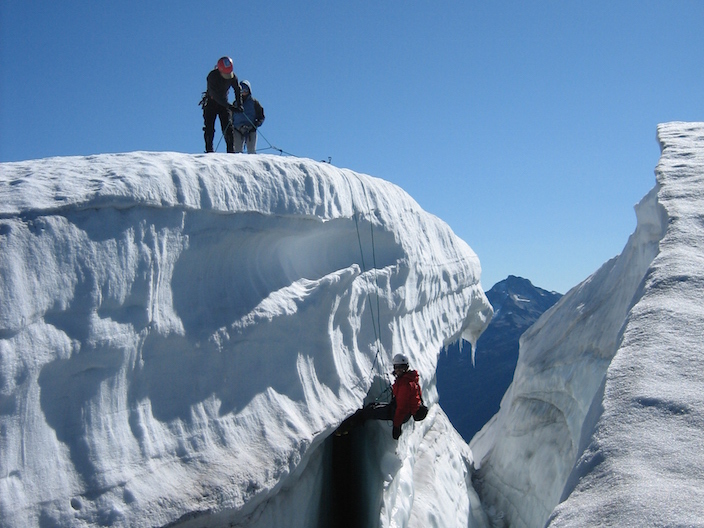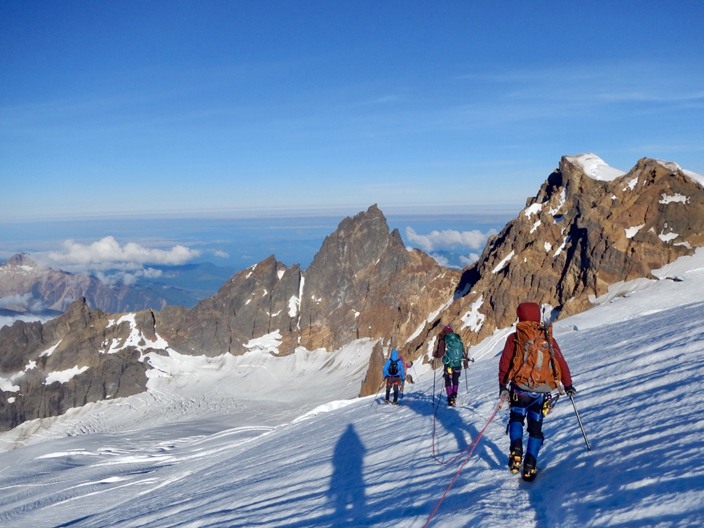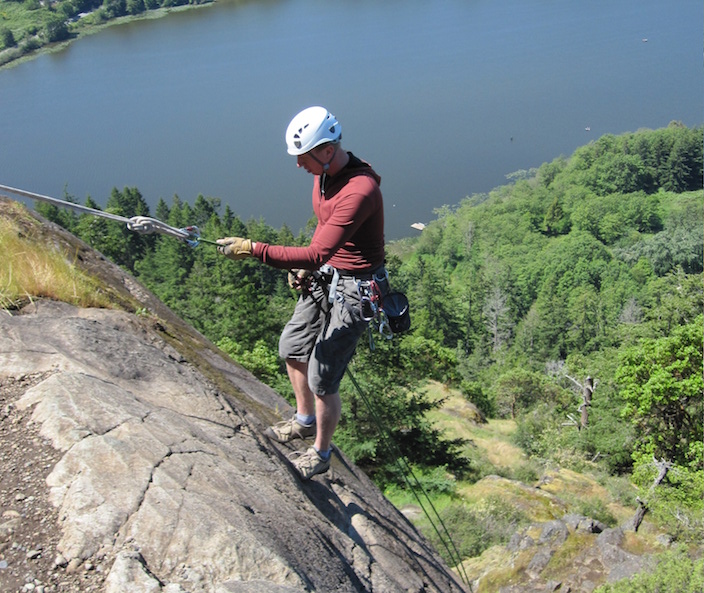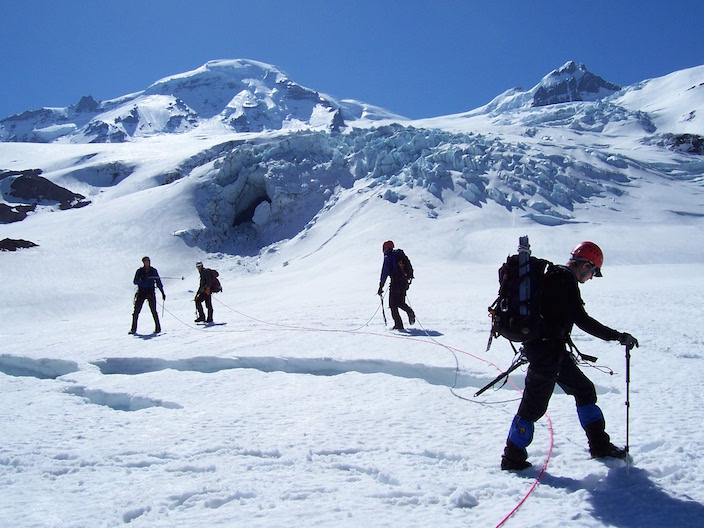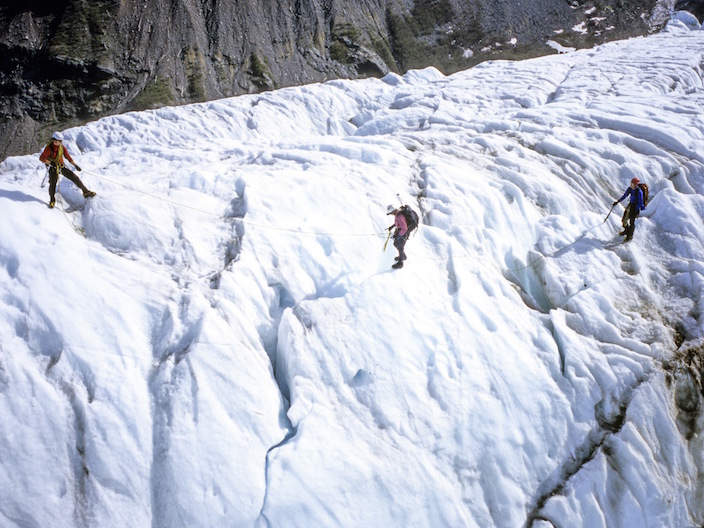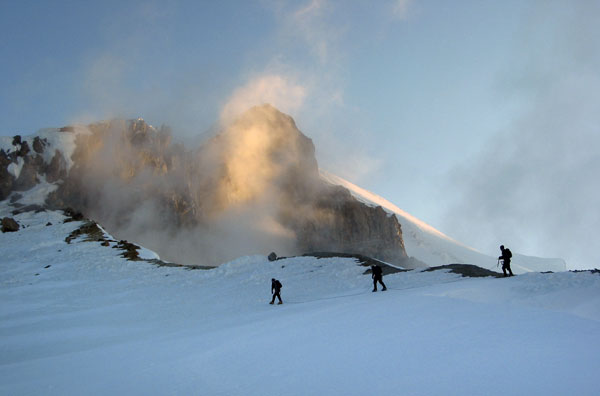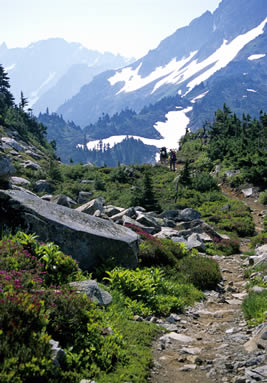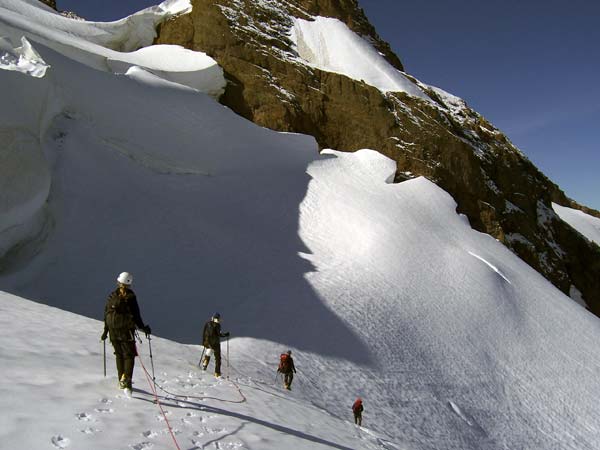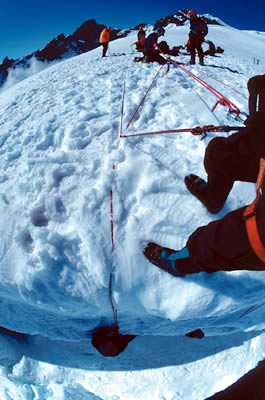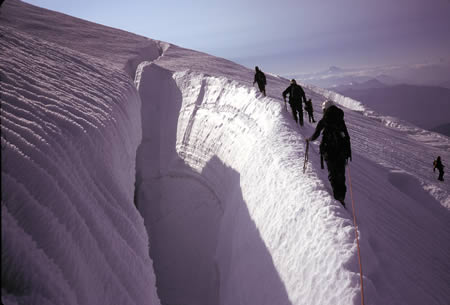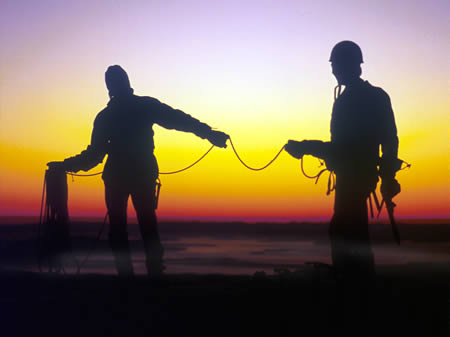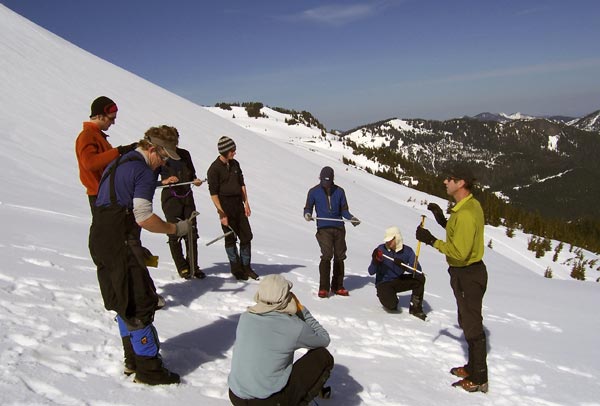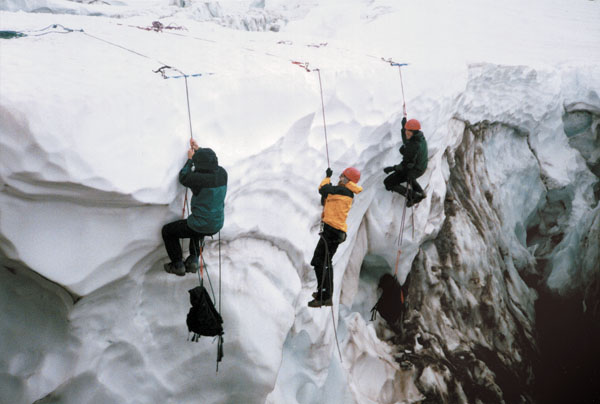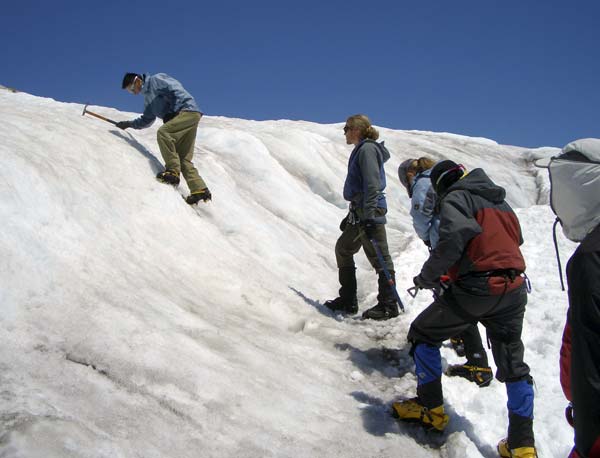Alpinism 1 - Introduction to Mountaineering Overview The Outdoor Life Network included this course in a recent series on America's Top 10 Adventure Sports Camps. This is definitely not a "camp" in the traditional sense, rather it is a rigorous alpine climbing course with small groups (maximum 10 climbers) in a remote wilderness setting. It is one of AAI's classics and perhaps the most comprehensive one-week climbing course in the nation, unbeatable for its combination of fun, learning, and achievement.
Alpinism 1 from John Grace on Vimeo .
The course provides a complete introduction to off-trail alpine travel and to all the fundamental skills of rock, snow, and ice climbing. We spend one day in an easily accessible rock climbing area, and five days learning and applying the skills of glacier travel and snow and ice climbing. On the fifth day, we set up a high glacier camp (with some of the most remarkable mountain and ocean views in America), and on the final day, we climb to the rugged, ice-encrusted summit of 10,778-foot Mt. Baker.
The incredible Sherman Crater of Mt. Baker. The final push to the summit skirts the crater rim on the left and ascends the snow slope called the 'Roman Wall' to the left of the photo. Ryan Slaybaugh
The Intro to Alpinism course is conducted largely above timberline in the high country of North Cascades National Park and Mt. Baker National Forest . Distances covered while backpacking into our base camps are kept to a minimum, usually about four miles, because of our emphasis on skills development and practice climbing.
You'll come away awed by the terrain you have seen, proud of your accomplishments, and you will have the knowledge and experience to operate as a skilled rope team member on climbs of intermediate difficulty.
Alpinism 1 - Introduction to Mountaineering Curriculum An AAI group takes a break during 'snow school' to show their enthusiasm for learning new skills. Dyan Padagas
This course is intended to serve as an intensive and complete introduction to off-trail alpine travel, and to all the fundamental alpine mountaineering skills of rock, snow, and ice climbing. The course is presented in the most highly glaciated area in the conterminous forty-eight states and offers exposure to an unusually large variety of landforms and climbing surfaces.
Upon completion of the program, each participant should be qualified as a technically competent rope team member capable of making alpine mountaineering ascents on glaciated routes of intermediate difficulty.
Itinerary and Curriculum Details Day 1 - Rendezvous at the AAI Equipment Shop and Rock Climbing Day
Plan to meet your fellow climbers and instructor(s) at the AAI Equipment Shop promptly at 7:00 am. Your Guide and an Equipment Specialist will take the time to go over your gear, finalize rentals and purchases, review the itinerary, and ensure everyone is adequately prepared.
As soon as the rendezvous is complete, we will travel to Mt. Erie. This climbing area overlooking the North Puget Sound will be the classroom for the day.
Curriculum : We will cover gear selection and use, basic concepts of free climbing, rappelling, anchor placement, belaying, knot tying, and movement on rock.
Day 2 - Hike to Camp on Mt. Baker (5600ft/1706m)
Curriculum : Concepts of alpine camping techniques and ecology, Leave No Trace principles , glacier travel, glaciology, mountain weather, geology, and the rough schedule for the next few days.
Day 3 - Snow School on the Glaciers (6500ft/1981m)
Curriculum : We will cover the concepts of self-arresting, self-belay, crampon techniques, glacier travel, and rope team skills and management. We will also cover mountain weather, first aid, and touch on avalanche hazard evaluation.
Day 4 - Crevasse Rescue (6500ft/1981m) Curriculum : Crevasse rescue: Setting up and practicing hauling systems, building snow anchors, prusiking up a rope, etc.
Day 5 - Snow Skills and Crevasse Rescue Continued Curriculum : Crevasse rescue continued. If time, basic ice climbing skills.
Day 6 - Summit Bid and Hike Out (10,778/3285m)
After the summit bid, we will hike down, pack up camp, and hike out to the vans. We will then drive back to the AAI headquarters. Plan to be back at the office anywhere between 3 pm to 7 pm.
Curriculum : Summit strategies, route finding, navigation, and hazard assessment.
Save
Save
Save
Alpinism 1 - Introduction to Mountaineering Dates Climbers coil their rope at the end of a great day at Mt. Erie.
2025
June 29 - July 4, 2025 - FULL
July 06 - July 11, 2025 - FULL
July 13 - July 18, 2025- Womxn's Only
July 13 - July 18, 2025 - FULL
July 20 - July 25, 2025 - FULL
July 27 - Aug 01, 2025
Aug 03 - Aug 08, 2025
Aug 10 - Aug 15, 2025
Aug 11 - Aug 16, 2025 - LGBTQ+ Only
Aug 17 - Aug 22, 2025
Aug 24 - Aug 29, 2025
Aug 31 - Sept 05, 2025
Sept 07 - Sept 12, 2025
Sept 14 - Sept 19, 2025
Sept 21 - Sept 26, 2025
Variations throughout the season... While all of these courses run during what we consider the "summer season," there is a large amount of variability in the weather and conditions that a climber could experience throughout this time. We recognize that most of our participants sign up for our programs weeks or months in advance, and although we can never be fully certain of what we'll encounter in the mountains that far out, you can click here for a description of what can typically be expected throughout the summer as well as a guide on picking the timeframe that is best for you
**The May 18-23 session is part of our new instructor orientation. It will be overseen on the mountain by multiple Tenured AAI Instructors, but will also include new instructors practicing their teaching skills. This course is offered at a $200 discount.
Women's Specific Programs
Our women's specific programs are for all individuals who identify as female, and are taught by female instructors. We cover the exact same skills and techniques as the co-ed courses.
Alpinism 1 - Introduction to Mountaineering Details Prerequisites
Good physical fitness, including
Ability to carry a 45 - 55 lb backpack for multiple hours
Stamina to hike for over 8 hours (including breaks, and with lesser pack weight)
Ability to cook for yourself on a backpacking stove
Overnight backpacking experience
If you lack overnight backpacking experience, you can add a 2-day Backpacking and Wilderness Skills
All Programs Max Ratio - 5:1 or 10:2 (Climber:Guide)
Capacity - 10
Cost Inclusions and Exclusions
Inclusions: Included in the course cost is group technical climbing equipment (personal climbing equipment is available for rent at a nominal charge), transportation to the climbing areas from AAI headquarters, all permits and camping fees, and the guide fee.
Exclusions: Not included in the course cost is all personal clothing and climbing gear (including crampons, ice axe, harness, helmet, tent, etc), gratuities to guide, meals while on the course, or travel insurance.
We also offer a porter program for individuals who require physical assistance. Call or email our office for more information.
Navigation Programs
Though this program does cover backcountry navigation, there is limited time. Some mountaineers choose to enhance their glacier navigation skills before or after a program by combining this class with either the three-hour Backcountry Navigation Essentials class, or the one-day Backcountry Navigation Comprehensive program.
Alpinism 1 - Introduction to Mountaineering Testimonials
Learning proper cramponing technique on the spectacular glaciers of
Mt. Baker. Andrew Yasso
"Few things in life turn out to be as advertised. The Alpinism 1
program I just completed is one of those few, and more. It was an
overwhelmingly positive experience. Our guides Alasdair and Richard
are fine leaders and teachers. I felt comfortable and confident in
their hands, and learned a great deal from them. I'm already
looking forward to my next climbing adventure with you. Thanks for
a marvelous time, and best regards."David Bruhn, Hudson, WI
"We agreed our guide was the greatest. He instinctively knew
where we were on our skill progression, what he needed to tell us,
and what he needed to leave unsaid. His directions and demos were
crystal clear and he was generous with his time and expertise. I
have been taught /guided by a lot of great professionals in various
adventure sports but based on the past six days, I think our guide
was the best of all."Jim Ledvinka, Athens, GA
"In my search to find the right organization to help me achieve
my goal to climb Denali, I researched about ten guide services.
American Alpine Institute met or exceeded all of the others in
training, experience, and integrity. I would not consider climbing
with anyone else but AAI."Tim Bullard, Houston, TX
"I would not hesitate to come back and climb with AAI. My
experience was wonderful and my guide was a true
professional."Donald Rickson, Westfield, MA
"During the ascent of Mt. Baker, our guide encouraged us to
explore our limits, but took great care to make certain that we
never felt "in over our heads", and was very vigilant in protecting
our safety."Andy Meacham, Denver, CO
Alpinism 1 - Introduction to Mountaineering Related Courses
Program Finder
By Location
United States - Alaska
United States - Washington
United States - California
United States - Nevada
United States - Colorado
United States - Utah
Canada - British Columbia
South America - Argentina
South America - Bolivia
South America - Ecuador
South America - Patagonia
South America - Peru
Europe - Alps and Caucasus
Asia - Nepal and Tibet
Asia - Laos, Thailand, & Vietnam
Asia - China
Asia - Japan
Africa - Tanzania
Pacific and Antarctica
By Program Type
Instructional Courses
Group Summit Climbs
Expeditions
Skills Expeditions
Private Guided Programs
Treks, Tours, & Backpacking
Corporate Outings & Services
Government & Military
By Activity
Rock Climbing
Ice Climbing
Alpine Climbing
High-Altitude Climbing
Trekking and Backpacking
Skiing & Snowboarding
Guide Training & Rescue
Avalanche Training
Departure Month
July
August
September
October
November
December
Difficulty Level
Beginner
Moderate
Intermediate
Advanced
Very Advanced
x
